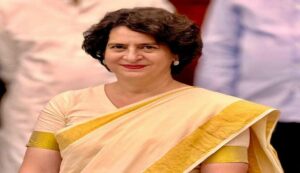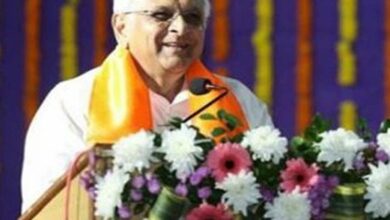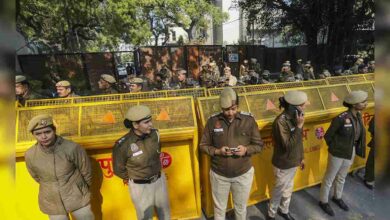MP Priyanka Gandhi entered the Parliament wearing Kerala’s traditional Kasavu saree
Kerala: There was more than a simple gesture to the state that Wayanad MP Priyanka Gandhi now represents as she entered Parliament wearing a traditional Kerala kasavu saree. Her decision both carried on a family history and represented her ties to Kerala‘s rich cultural legacy. She was the third generation of Gandhis to wear this famous white-and-gold weave, which was previously worn by Indira Gandhi and Sonia Gandhi.

There was more to her decision to wear a kasavu (gold weave) saree than just politics. It served as a reminder of the beauty and tenacity of India’s traditional handlooms as well as a celebration of Kerala’s timeless artistry.
“Priyanka Gandhi wearing the traditional Kasavu saree in Parliament is a source of pride for Kerala. Even Sonia Gandhi and Indira Gandhi, her mother and grandmother, had stolen Kasavu sarees from our shop. The owner of Karalkada, a company well-known in Kerala for its kasavu sarees and mundus (dhotis), Anish Rajendran, said, “We have a picture of Rajiv Gandhi and Sonia Gandhi wearing the kasavu bought from us.”
The Kasavu saree is a symbol of the state’s weaving legacy because of its subtle grace and beauty, cream hues, and golden borders. It is deeply ingrained in Kerala’s social, cultural, and economic fabric and has a long history.
The Kasavu Saree’s creation
Experts in the area believe that the kasavu, which was formerly a component of a two-piece garment called “mundum neriyathum,” may have originated during Kerala’s Buddhist period.
“The purest and best gold for kasavu, or the gold used in saree weaving, is obtained from Surat.” The gold kasavu is woven from the finest mulberry silk, and it not only reflects Keralan tradition but also the labor and sweat of the weavers who make this magnificent fabric,” P. Gopinath told News18.
Gopinath, a 2007 Padma Shri recipient, has been weaving this well-known cloth for fifty years.
Gandhi’s public exhibition of the saree gave Keralan weavers, who work to preserve this age-old craft, hope. It promoted the craft on a national scale, highlighting the talented craftspeople and their dedication to conserving this legacy.
The ancient craft of weaving the Kasavu is not even practiced by a small number of weavers. “This work, which is not only intricate and time-consuming but also steeped in deep culture and craftsmanship at a time and age when power looms are available,” Gopinath said, adding that he was delighted to have woven one of the kasavu sarees delivered to Wayanad for Priyanka Gandhi.
Anish’s wife, Deepa, observes that while the Kasavu is unique and has a considerable following, there is a belief that the younger generation does not value handloom art enough.
She said that this kind of attention revives the passion for the handloom and the appreciation of genuine sari and pure kasavu.
The blossoming of Kerala’s handloom industry is attributed to King Balarama Varma of Travancore, who reigned from 1798 to 1810, and his Chief Minister, Ummini Thampi. A group of weavers from Nagercoil, Tamil Nadu, known as the “Shaaliyars,” were brought in by the then-chief minister and placed on a street named Shaaliyar Street.
These exquisite textiles were woven for the Travancore royal family in Thiruvananthapuram by the townspeople, who turned the local cotton market into an industry. The region is known as the Balaramapuram Weaving Society, most likely in honor of Balarama Varma.
Kasavu and Kerala attire
The Kasavu saree is praised for its elegance and simplicity and is often connected to festivals, weddings, and traditional dances like “Mohiniattam” and “Kaikottikali.”
“Kasavu exalts our history and distinguishes Mohiniattam dance from other artistic disciplines that use vibrant textiles. This has an off-white tranquility that is simple and calming. As noted Mohiniattam dancer Dr. Neena Prasad told News18, “The kasavu saree gives the dance form a uniqueness and distinct personality.”
According to her, the fabric represents Kerala, which is both sumptuous and valuable, like the gold border of the saree, and simple and pure, like the state’s people.
One state that is said to have a strong affinity for gold is Kerala. However, humans have extremely basic daily routines and have quite modest lives. A Kasavu saree and a drop of gold are all that are needed for a marriage, she said.
According to certain historical sources, its design was also influenced by Greco-Roman art, especially the flowing, unstitched fabric with colorful or elaborate borders. The transformation of the mundum neriyathum into the modern single-piece Kasavu saree is evidence of Kerala’s thriving handloom culture.
With the introduction of exquisite cotton weaving methods, the artists gave the mundum neriyathum a royal rank via the gold weave, garnering attention from all over the world. Portuguese and Dutch merchants were eager to export the fabrics.
It’s interesting to note that the barter system that was common in Kerala, where spices were traded for gold, is claimed to have paralleled the growth of the Kasavu saree. The distinctive golden zari borders of the Kasavu saree made their way into the barter system as a result of upper-class women’s astute incorporation of this gold into their clothing.
The famous sari has also influenced art and culture. Raja Ravi Varma, the former monarch of Travancore, immortalized it in his paintings by fusing traditional drawing techniques with modern interpretations. In a number of his paintings, including the well-known Shakuntala picture from the Mahabharata, Raja Ravi Varma portrayed the Kasavu.
Anish of Karalkada said, “We have been weaving the kasavu for the royal family for decades now, and this forms a big part of the handloom royalty and legacy.”
These days, Balaramapuram, Chendamangalam, and Kuthampully—three important handloom clusters in Kerala—are home to this handloom weaving, which is also marked with Geographical Indication (GI) tags.





